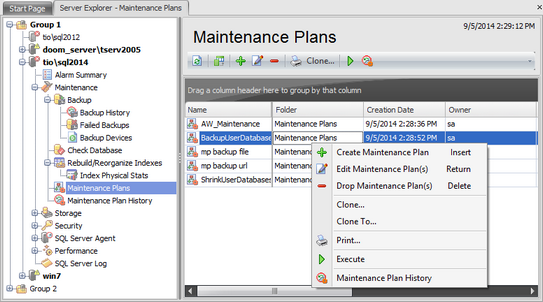Online Documentation for SQL Administrator for SQL Server
Maintenance plans
Maintenance plans create a workflow of the tasks required to make sure that your database is optimized, regularly backed up, and free of inconsistencies.
Note: To create and edit maintenance plans a login must be a System Administrator role member.

SQL Server maintenance plans provide the following features:
- Workflow creation using a variety of typical maintenance tasks. You can also create your own custom Transact-SQL scripts.
- Conceptual hierarchies. Each plan lets you create or edit task workflows. Tasks in each plan can be grouped into subplans, which can be scheduled to run at different times.
- Support for multiserver plans that can be used in master server/target server environments.
- Support for logging plan history to remote servers.
- Support for Windows Authentication and SQL Server Authentication. When possible, use Windows Authentication.
Use the context menu or buttons on the work area toolbar to manage the list of maintenance plans:
![]() create a new maintenance plan
create a new maintenance plan
![]() edit selected maintenance plan
edit selected maintenance plan
![]() drop selected maintenance plan
drop selected maintenance plan
- create the object copy on the same server
- clone the object copy to another server
![]() execute selected maintenance plan
execute selected maintenance plan
![]() create and print the report
create and print the report
The list displays the existing maintenance plans as a grid with the following columns: Name, Folder, Application, Creation Date, Owner, Reader Role, Writer Role, Encrypted, Description. If more convenient, you can change the order of the columns by dragging their headers horizontally. See the Working with grid section of the SQL Administrator documentation to find out operations that can be performed with the grid.
To open a Maintenance Plan in the Maintenance Plan Editor, double-click it in the grid. Alternatively, you can right-click the Maintenance Plan alias and select the Edit Login(s) context menu item.
|
See also: |



































































